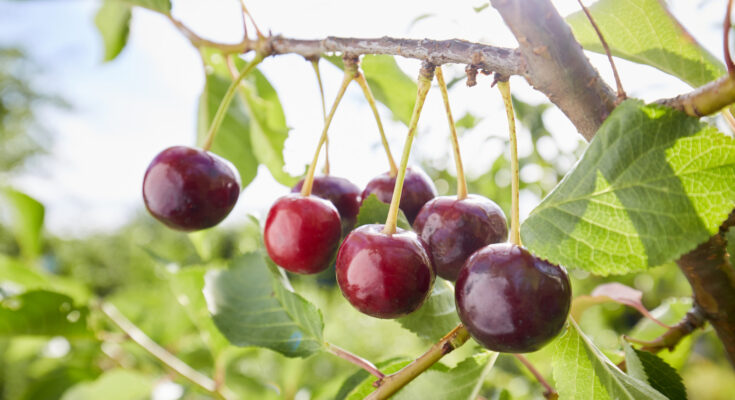16 Cherry Tree Varieties To Plant And Grow For Juicy Fruit
When you hear cherry trees, your mind might immediately spring to the beautiful cherry blossoms that unfurl during spring, perking up parks, street walks, and your home. But there’s more to cherry trees than ornate blooms; plenty of them grow edible fruit — not just for birds, but for us measly humans, too. In the U.S., you will broadly find tart (Prunus cerasus) or sweet (Prunus avium) cherries, where the former are best baked into goodies or preserves, while their sweet counterparts are enjoyed freshly plucked off the tree. These main varieties are further divided into different cultivars, which exhibit variations across bloom times, forms, tastes, textures, and colors. For instance, tart or sour cultivars include ‘Montmorency,’ ‘North Star,’ ‘Meteor,’ and more (1 through 7 in the list). In contrast, sweet cherries encapsulate ‘Bing,’ ‘Rainier,’ ‘Stella,’ and ‘Black Tartarian,’ among others, making up the rest of the list.
Before growing cherry trees for fruit, please note that both tart and sweet cherries are invasive in various U.S. regions. So, you must check with your local state extension before planting. Regardless of the variety, cherry trees are best grown in full sun sites, shielded from winds. They also need well-draining soils. Follow the proper care instructions mentioned on the label to minimize disease pressure and pesticide use that may harm the tree or local pollinators. Below follows the discussion on the best cherry tree varieties to grow for juicy fruit.
Montmorency cherry tree
If you’re into baking pies or making jams, you cannot go wrong with the Montmorency cherry tree (Prunus cerasus ‘Montmorency’). A hybrid, ‘Montmorency’ is the go-to tart cherry variety for the majority of North America. The red fruits have a rich, tangy flavor and become available by June end. Also, ‘Montmorency’ is self-fruitful, which is great for small yards where planting in pairs isn’t feasible. However, planting another variety will enhance the yield. This fast-growing fruit tree will start bearing fruit within two to five years of planting. It tolerates temperatures down to -20 degrees Fahrenheit.
North Star sour cherry
For your small garden space, you should consider dwarf plants like North Star sour cherry (Prunus ‘North Star’) that top out at 9 feet. That way, netting them to protect the harvest from birds will also be easier. Like ‘Montmorency’, ‘North Star’ is self-fruitful and yields fruits by June end, or sometimes, early July. However, it can start producing within the first planting year — profusely at that. The tree retains the fruits for about two weeks, which can be consumed fresh or preserved. As a plus, it can withstand brown rot and leaf spot to a limited extent.
Meteor cherry
If your idea of a luscious cherry revolves around a plump, glistening red fruit, you’re probably thinking of Meteor cherry (Prunus cerasus ‘Meteor’). Growing about 8 feet wide and tall, this compact tart cherry cultivar is a great find for gardeners with limited area to spare. Plus, it’s self-fertile and bears produce within a couple of years of planting, usually a week after ‘Montmorency.’ Better still, ‘Meteor’ is very cold-hardy and can tolerate mercurial dips to -40 degrees Fahrenheit! It also shows resistance to blossom blight and leaf spot.
English Morello cherry
If you’re weary of late frosts damaging the flower buds on your fruit trees, consider English Morello cherry (Prunus cerasus ‘Morello’) tree instead because it’s a late bloomer. By extension, the Morello cherry tree produces a perfect pucker in August without requiring any companion for cross-fertilization. However, its long blooming season does make it a wonderful companion to other self-incompatible cherry tree varieties. Since this prolific producer only requires about 450 chill hours, you can even grow it in zone 9. You can have them raw if they’re extremely ripe (will appear near-black); otherwise, can them.
Danube cherry
If you find tart cherries too astringent for your liking, give the Danube cherry (Prunus cerasus x avium ‘Danube’) a chance. Despite belonging to the tart cherry family, this dwarf hybrid plant boasts higher sugar concentration and so comes off as savory. The mahogany red fruits are best enjoyed fresh off the tree, though you may cook them or bake them into pies as desired. ‘Danube’ ripens earlier than most cherries, including Montmorency,’ yet is hardy through zone 4. Although considered self-compatible, they’ll produce better in the company of ‘Morello’ or ‘Almaden Duke.’
Balaton cherry
Hugely popular in Hungary, Balaton cherry (Prunus cerasus ‘Balaton’) is another tart cherry variety you could check out. Compared to ‘Montmorency,’ it grows and yields faster. Also, the fruits appear brighter and taste sweeter, making them a superior choice for baked goodies, though they’re just as nice fresh. As ‘Balaton’ cherries sport firmer bodies, these trees can stand being in rainy locations. However, as they’re early bloomers, you must avoid growing them in low-lying areas and prefer sloped locations in cold regions (especially zone 4). Companion planting with ‘Black Gold’ will encourage better fruiting.
Evans Bali cherry
Although Evans Bali cherry (Prunus bali) is a tart cherry variety, it leans closer to sweet cherries in taste. Even better, it shows high cold resilience, courtesy of its Alberta origins. So, it can be grown as high as zone 2. Evan Bali cherry trees are heavy producers, though they may take between three and four years to start bearing. Unlike similarly cold-hardy cultivars, ‘Meteor,’ they bloom late in the season. Bali cherry resists most cherry diseases, save for leaf spot. As they’re extremely popular with birds, consider using these tips and tricks to prevent them from munching on your garden fruit.
Black Tartarian cherry
When you’re looking to start a home orchard with sweet cherry trees, Black Tartarian cherry (Prunus avium ‘Black Tartarian’) may be a nice option. Although it isn’t self-fertile and requires a companion to produce fruit, ‘Black Tartarian’ can get along with a range of cherry varieties, including ‘Rainier’ and ‘Bing,’ functioning as their pollinizer. Since it requires about 800 chill hours, it’s best grown in zones 5 through 8 — three years in, and it’ll commence producing juicy, heart-shaped red or purple fruit that is enjoyed raw or preserved. Be wary of the bird competition.
Bing cherry
Love the sweet cherries hogging space on the market shelves? Are they shaped like a heart, with pits coated in a meaty, mahogany flesh? Chances are you’re looking for Bing cherry (Prunus avium ‘Bing’). Delectably delicious, Bing is perhaps the most popular sweet cherry variety, at least in the western U.S., and you can grow it easily in your home garden in zones 5 to 8. Be warned, you must wait for nearly five years before the cherry tree produces any fruit. Also, couple it with a compatible pollinator like ‘Montmorency,’ ‘Stella,’ or ‘Rainier.’
Utah Giant cherry
A favorite in Utah, as you would expect given the name, Utah Giant (Prunus avium ‘Utah Giant’) is a sweet cherry variety well adapted to zones 5 through 9, as long as it experiences about 800 chill hours. If you’ve tasted ‘Bing’ before, you’ll find ‘Utah Giant’ bears larger fruit, which tastes even sweeter and holds its red hue and form through the summer heat. Expect to harvest mid-summer, during May end or early June, after giving it Stella or Van as companion pollinizers. Although the cherries are great for preservation, they aren’t crack-resistant. The tree is reliable against most cherry diseases.
Lambert cherry
Another commercial favorite like Bing, Lambert cherry tree (Prunus avium ‘Lambert’) will leave you lip-smacking with its highly saccharine, blackish-red bodied, heart-shaped cherries that are best had fresh. As it only requires about 800 chilling hours, you can grow Lambert even in zone 9, though it stops being winter-hardy below zone 4. This heirloom variety is a late bloomer, with the crop ready for harvest around mid-to-late July. Due to late production, the large fruit is less likely to crack prematurely. Lambert bears a heavy crop, provided it’s paired with a compatible pollinator, such as Rainier or Van.
Stella cherry
When you want sweet cherries without the headache of arranging a pollinizer, buy the Stella cherry tree (Prunus avium ‘Stella’). Since it doesn’t usually grow beyond 12 feet and has moderate growth, it works great in stamp-sized yards. ‘Stella’ can be grown in zones 5 through 8, but the buds are sensitive to late spring frosts. Dark, heart-shaped, red fruit is produced early in the summer, within five years of planting, and doesn’t crack easily. Be aware that mammals will browse their foliage, and birds will run off with their fruit if you don’t harvest on time.
Rainier cherry
If you’re looking for fruit trees that produce the first year after transplanting, you may have luck with the Rainier cherry tree (Prunus avium ‘Rainier’) in zones 5 through 8. Like Stella, Rainier doesn’t grow vigorously, maxes out under 15 feet, and is ideal in small gardens. However, it requires a different cherry variety, like ‘Black Tartarian’ or ‘Bing,’ to aid cross-pollination. In their company, Rainier will beguile you with sweet, red-blushed, yellow-fleshed cherries, generally produced in abundance in the summer (June end to early July). Fruits are crack-resistant and can be consumed fresh or frozen for later use.
Van cherry
If you like everything about ‘Bing’ but abhor how easily the sweet fruit pops open, consider the Van cherry tree (Prunus avium ‘Van’). Its juicy fruit is firm and crack-resistant, albeit slightly smaller than Bing, and is ready for harvest by spring end (usually no later than mid-June) and lasts through early summer. Plus, it looks ornamental, with the glossy, red, ruby-looking cherries eventually growing a dark, near-black skin. Van is a prolific producer and will cross-pollinate with most cherry varieties, save for ‘Regina.’ It’s available in both dwarf and semi-dwarf forms, so pick the form that best fits your yard’s dimensions.
Royal Ann cherry
Despite its small frame that settles at around 15 feet, the Royal Ann cherry tree (Prunus avium ‘Royal Ann’) packs a massive punch — around 50 pounds heavy — because it produces so copiously. Like ‘Rainier,’ it bears large, red-tinted, blonde cherries that become available during the summer. However, because they taste sweeter and are soft-bodied, they’re preferred for fresh consumption; their pleasant aroma is another plus. ‘Royal Ann’ can grow in zone 8 and north, right up to zone 5, though it’s particularly successful in the Midwest, where extreme seasonal variations are the norm. ‘Stella,’ ‘Rainier,’ or ‘Montmorency’ are suitable co-pollinators.
Starkrimson Sweet cherry
A Stark Bro’s introduction, Starkrimson Sweet is the trade name for Lapins cherry (Prunus avium ‘Lapins’), and growing it is sure to make you popular with your neighbors. That’s because Starkrimson Sweet is compatible with several sweet cherry tree varieties within 100 feet, though it doesn’t necessarily require their company, in turn, to bear fruit. The fruits are sizable and sweet like Bing, sporting a glossy red flesh when they appear during June, yet they resist cracking. A semi-dwarf variety, Starkrimson Sweet grows over 12 feet high and similarly wide in zones 5 through 8 and produces plentifully.



